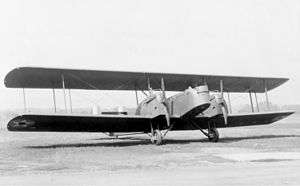Elias XNBS-3
| Elias XNBS-3 | |
|---|---|
 | |
| Role | Night bomber |
| National origin | United States |
| Manufacturer | Elias |
| Primary user | United States Army Air Corps |
| Number built | 1 |
The Elias XNBS-3 was a 1920s prototype biplane bomber built by Elias for the United States Army Air Corps.[1]
Development
The XNBS-3 was a large biplane bomber with a steel tube fuselage and powered by two 425 hp (317 kW) Liberty 12A piston engines.[1] It had a conventional landing gear with a tailskid and a crew of four. The prototype was designated XNBS-3 (prototype night bomber short distance) and tested by the Army Air Corps in 1924 at McCook Field. It was similar to the earlier Martin NBS-1 and was no real improvement, so it was not ordered into production.[2]
Operators
Specifications
Data from [2] National Museum of the United States Air Force
General characteristics
- Crew: four
- Length: 48 ft 5 in (14.76 m)
- Wingspan: 77 ft 6 in (23.63 m)
- Height: 16 ft 10 in (5.13 m)
- Gross weight: 14427 lb (10763 kg)
- Powerplant: 2 × Liberty 12A, 425 hp (317 kW) each
Performance
- Maximum speed: 101 mph ( km/h)
- Range: 465 miles (748 km)
- Service ceiling: 8680 ft ( m)
Armament
- 1692 lbs of bombs
- Five 0.30in machine-guns
See also
- Aircraft of comparable role, configuration and era
- Related lists
References
| Wikimedia Commons has media related to Elias XNBS-3. |
Notes
- 1 2 Andrade 1979, p. 136
- 1 2 "Elias XNBS-3". National Museum of the United States Air Force. Archived from the original on 16 June 2012. Retrieved 11 June 2010.
Bibliography
- Andrade, John (1979). U.S.Military Aircraft Designations and Serials since 1909. Midland Counties Publications. ISBN 0-904597-22-9.
This article is issued from
Wikipedia.
The text is licensed under Creative Commons - Attribution - Sharealike.
Additional terms may apply for the media files.